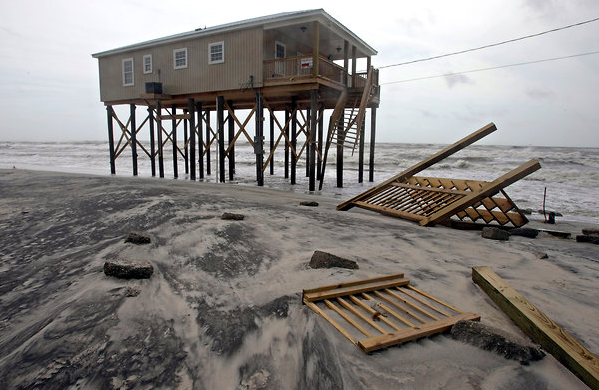As coasts rebuild and U.S. pays, repeatedly, the critics ask why
By JUSTIN GILLIS and FELICITY BARRINGER
18 November 2012 DAUPHIN ISLAND, Alabama (The New York Times) – Even in the off season, the pastel beach houses lining a skinny strip of sand here are a testament to the good life. They are also a monument to the generosity of the federal government. The western end of this Gulf Coast island has proved to be one of the most hazardous places in the country for waterfront property. Since 1979, nearly a dozen hurricanes and large storms have rolled in and knocked down houses, chewed up sewers and water pipes and hurled sand onto the roads. Yet time and again, checks from Washington have allowed the town to put itself back together. Across the nation, tens of billions of tax dollars have been spent on subsidizing coastal reconstruction in the aftermath of storms, usually with little consideration of whether it actually makes sense to keep rebuilding in disaster-prone areas. If history is any guide, a large fraction of the federal money allotted to New York, New Jersey and other states recovering from Hurricane Sandy — an amount that could exceed $30 billion — will be used the same way. Tax money will go toward putting things back as they were, essentially duplicating the vulnerability that existed before the hurricane. “We’re Americans, damn it,” said Robert S. Young, a North Carolina geologist who has studied the way communities like Dauphin Island respond to storms. “Retreat is a dirty word.” This island community of roughly 1,300 year-round residents has become a symbol of that reflexive policy. Like many other beachfront towns, Dauphin Island has benefited from the Stafford Act, a federal law that taps the United States Treasury for 75 percent or more of the cost of fixing storm-damaged infrastructure, like roads and utilities. At least $80 million, adjusted for inflation, has gone into patching up this one island since 1979 — more than $60,000 for every permanent resident. That does not include payments of $72 million to homeowners from the highly subsidized federal flood insurance program. Lately, scientists, budget-conscious lawmakers and advocacy groups across the political spectrum have argued that these subsidies waste money, put lives at risk and make no sense in an era of changing climate and rising seas. Some of them contend that reconstruction money should be tightly coupled with requirements that coastal communities begin reducing their vulnerability in the short run and that towns along shorelines facing the largest risks make plans for withdrawal over the long term. “The best thing that could possibly come out of Sandy is if the political establishment was willing to say, ‘Let’s have a conversation about how we do this differently the next time,’ ” said Dr. Young, a coastal geologist who directs the Program for the Study of Developed Shorelines at Western Carolina University. “We need to identify those areas — in advance — that it no longer makes sense to rebuild.” A coalition in Washington called SmarterSafer.org, made up of environmentalists, libertarians and budget watchdogs, contends that the subsidies have essentially become a destructive, unaffordable entitlement. “We simply can’t go on subsidizing enormous numbers of people to live in areas that are prone to huge natural disasters,” said Eli Lehrer, the president of the conservative R Street Institute, part of the coalition. […]
As Coasts Rebuild and U.S. Pays, Repeatedly, the Critics Ask Why
